Researched and written by Cory Alderfer.

When the Souderton Lions Club combined forces with the Rotary in 1927, it was a home run for 350 boys from Souderton, Telford, and Harleysville.
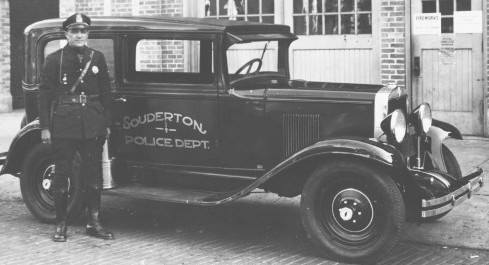
Police Chief George F. Kulp
On the afternoon of May 2 — a school day no less — a caravan of 80 specially marked cars was led to Philadelphia’s Shibe Park (later known as Connie Mack Stadium) by Souderton police chief George F. Kulp and the Keystone Automobile Club. They directed traffic from Chestnut Street Elementary School in Souderton, receiving every right of way, not stopping once enroute to the ball park on Lehigh Avenue, where the Philadelphia Athletics would play the Boston Red Sox.
This “Boys Week” celebration came about through the efforts of LeRoy G. Frederick, secretary of the Montgomery County League. He spoke with Connie Mack — partner of team president Ben Shibe — about free admission for the boys. Mack’s reply was succinct: “Bring the boys; we’ll be glad to have them.” A call went out for men to drive the boys, ages 9-16, for what the Souderton Independent headlined as “Big Treat in Store for Local Lads.”
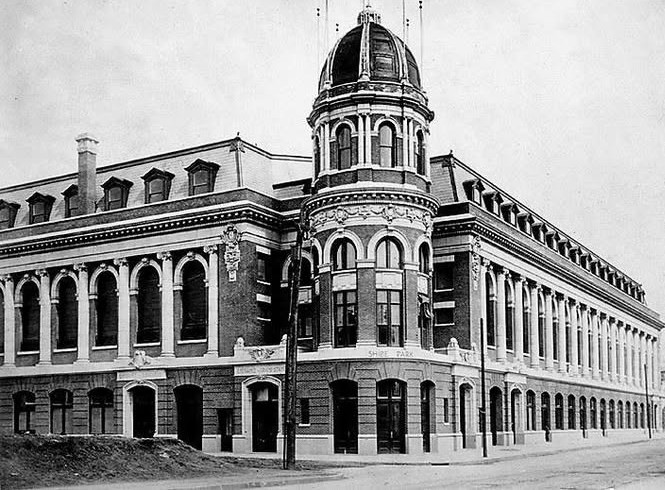
Shibe Park (later Connie Mack Stadium) Opened 1909.
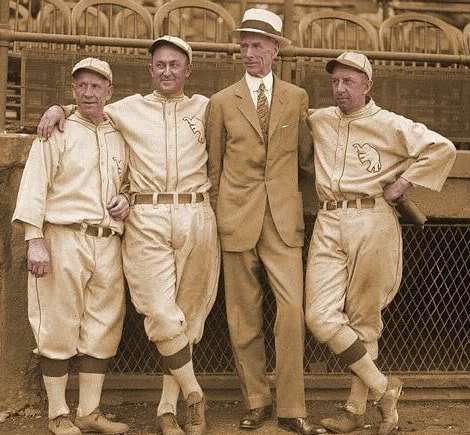
From left: Coach Kid Gleason, Ty Cobb, Manager Connie Mack, and Eddie Collins.
For many of the boys, it was their first visit to the big city. They and their chaperones were given VIP treatment they would not soon forget. Special parking, a dedicated entry gate, matching colored flat caps, and a never-ending supply of sandwiches, peanuts, ice cream, chocolate bars, and drinks — the dream of a lifetime.
During the seventh inning stretch, the crowd rose and belted out the revised 1927 verses to the 1908 Take Me Out to the Ballgame. But the greatest thrill was watching their favorite Philadelphia players, Ty Cobb and Eddie Collins, defeat the Red Sox 6 to 5. Seats in the right field stands allowed the group to keep an eye on Cobb, who had joined the team in the 1927 season after a long career with the Detroit Tigers. As the newspaper reported, “Ty held the eye of the youngsters … and featured in a number of plays through the afternoon.”
But in the ninth inning of a 10-inning game, the boys’ secret wish was fulfilled when a foul ball was hit into their section. Not just any foul, mind you, but one off the bat of Ty Cobb himself. After a crazy, mad scramble, Norman Kulp of Telford came home with the prized ball. It was a most memorable experience.
Reading about games in the Philadelphia Evening Bulletin or listening on a radio, if you owned one, was thrilling for sure. But seeing a live game could not be beat. Every boy wore a wide smile through the afternoon, the Independent wrote. The joy felt by those boys almost 100 years ago is infectious when you read the Independent’s coverage. Would it have been the same later in the 20th century?
The Souderton-Telford Historical Society caught up with two “local lads” who could answer that question: former Major League Baseball players Erik Kratz and Jamie Moyer. Kratz, a Telford resident, is a 1998 graduate of Christopher Dock High School (Dock Mennonite Academy). A catcher, he played for several teams in his 11-year career, including the Philadelphia Phillies. Moyer, a 1981 graduate of Souderton Area High School, now lives in Washington state. A pitcher, he also played for the hometown Phillies among others, over his 25-year career. We asked both men what it was like when they were kids growing up locally and being taken out to the ballgame.
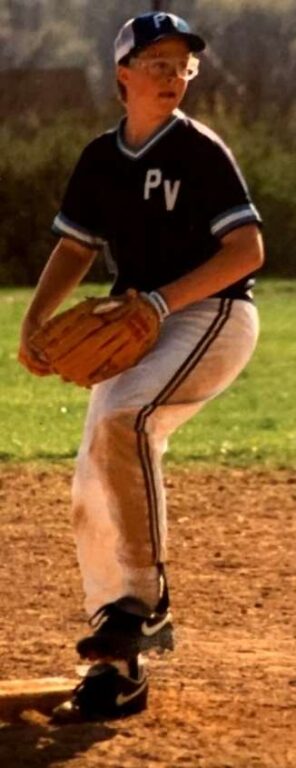
A youthful Erik Kratz pitching for Penn View Christian school in Telford.
It seems Erik Kratz was destined to play baseball. He doesn’t remember, but his parents have told him that they gave him a bat and a ball for his first birthday. “I just put the ball down and started whacking it around the yard. Nobody pitched it to me. I just would hit it and walk over to it and then hit it again.”
As Erik grew up, his baseball hero was the Phillies’ Mike Schmidt, which was true for many kids who followed the team in the 1980s. Schmidt is a Hall of Famer who played with the Phillies his entire career (1972-1989). “The cool thing,” Erik says, “is I got to know Mike later in life, and I talk to him occasionally to this day. He is cooler than I thought he was when he was my hero as a kid.”
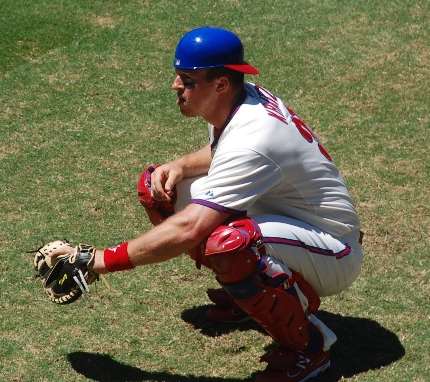
Erik in position as a catcher for the Phillies.
Like the boys who saw the A’s in 1927, Erik’s first game came thanks to free tickets. They were earned through participation in the Phillies Home Run Derby. “It is actually still going on, and my daughter won the whole thing, which was something I never was able to do as a kid,” he adds.
The Phils were playing the Cardinals at the now-gone Veterans Stadium. “Our tickets were in the 700 level, and I truly believed I was going to get a foul ball. I will never forget the color of the turf and how huge the stadium and the field looked.”
It was the same feeling he experienced as a player, walking into the stadium at the concourse level and seeing the field. “I am transported back to being seven years old. My dad took me and my sister, and there was a backpack giveaway, and each backpack came with a Three Musketeers bar that was melted by the time I finished the lunch my mom packed for us.”
The first time Erik’s son attended a baseball game was also memorable, in its own way. It was a spring training game in 2007. “We played the Rays at Al Lang field, and I had a sacrifice fly in my one at bat. Right before I went out to see my wife and son and my parents, I got called into the manager’s office and I got sent down to minor league camp.” Erik says he knew that would happen at some point in camp, but not at the first game that his son came to. The saving grace: “He was 5 months old, so he didn’t remember it.”
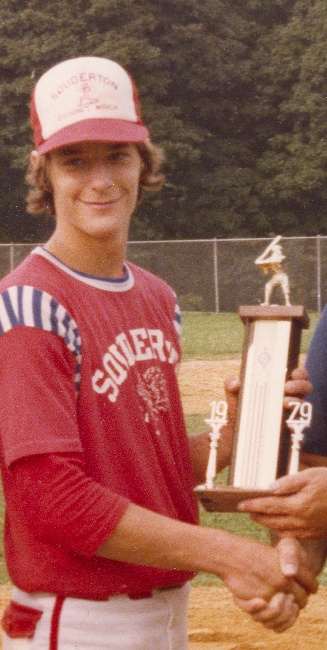
Jamie Moyer in 1979
Jamie Moyer also was around sports from a young age, inspired perhaps by his father Jim, who also played, including fast pitch softball all around Souderton and Telford. “I was a bat boy when I got old enough for my dad’s softball teams, and he coached me from eight years old through American Legion, which was 18 years old.”
He remembers that the Souderton Little League would travel as a large group at the end of the summer season to a Phillies game at Veterans Stadium. The group would sit in the upper deck. Jamie, looking back, says the expedition probably was a nightmare for the coaches who accompanied them.
“You’re trying to get kids to sit down but being so high up, the players almost look like ants on the field. … Kids don’t have that ability to sit and watch, especially at a nine-inning baseball game. So, it was like a track meet around the top of the stadium, or they’d wander around.”
But Jamie, with his dad as his coach, did not wander. “You’d stay in your seat. Watch the game. That’s why we’re here.” There were also Phillies games with his father and his buddies.
“We would go at some point during the summer when there was no fastpitch softball that my dad was playing and no Little League Baseball that I was playing,” he says. “We’d drive down …get the cooler out of the back of the car and we’d pull out our bologna and cheese sandwich. We’d have an A-Treat soda (a Pennsylvania brand still sold locally). … We’d just kind of hang out in the parking lot and then we’d go in and watch the game.” When Jamie was older, his father would decide spontaneously it was time to see the Phillies. “But we wouldn’t drive all the way to the game. … We would park at Olney, jump on a (subway) train, and go to a Phillies game.” The route was reversed on the way home.
Jamie says that he was not a big autograph seeker. “And never did we sit really, really low because seats were even expensive back then.”
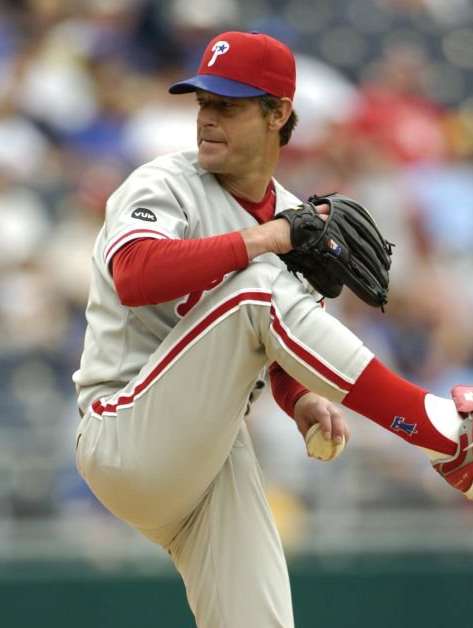
Jamie Moyer as a Phillies’ pitcher.
But one time, “I was down on the Philly side of the field, kind of between first base and maybe the picnic area, actually got an autograph from Johnny Briggs,” a left fielder who played for the Phillies from 1964-1971.
Later, when Jamie was in college, he would travel to a tournament in York, Pa., with the Collegeville team from the local Perky League. “They would invite me to go along with them because you can never have enough pitching. It was a Labor Day tournament, and teams would come from Delaware, New Jersey, Maryland, and Pennsylvania.”
His team once won the tournament with Jamie pitching three games in four days. “And I faced Johnny Briggs there. … I know two occasions I had him, no balls and two strikes. And he hit a home run, one to left field and one to right field. … So, I got a little humble pie there.” Jamie’s career would see him become at age 49 the oldest pitcher in Major League Baseball history to win a game, in 2012. So, there was more humble pie and a lot of ups and downs ahead of him, and he wouldn’t want it any other way.
“Baseball just brought me a lot of great experiences throughout my life. … It’s just been pretty cool to have the opportunity to play, number one. But make it to the major leagues, number two. And never did I think that I’d have a long career like I had. And then, you know, this probably should have been number one, to play on my hometown team.” Today, as a grandfather, Jamie compares his childhood in baseball to the experience some children in sports now have. “I had two wonderful parents supporting me. I was never pushed into doing anything as a young kid. But it was known that if I go out for a sport, I couldn’t quit. I had to stay with it. See it through. And that’s exactly what I did.”
And, he adds, “We weren’t getting in the car and driving to tournaments and on travel teams and flying on planes all over the country to play baseball. We played in our local area. And I was having fun. As a kid, you’re supposed to have fun.” Which bring us full circle to 1927, and a caravan of cars filled with 350 excited boys being taken out to the ballgame.
Learn more: Both Erik and Jamie have books about their baseball lives, receiving positive reviews from Publisher’s Weekly and baseball insiders alike. Just Tell Me I Can’t by Jamie Moyer and Larry Platt (2014) is described as the “appealing story of a sportsman with a good heart and a strong mind.” The Tao of the Backup Catcher: Playing Baseball for the Love of the Game by Tim Brown with Erik Kratz (2023) is called “an empathetic tribute to athletes who spend their lives just outside the spotlight.”
The Gazette is edited by Edie Adam. Email: newsletter@soudertontelfordhistory.org.
The Souderton-Telford Historical Society is a 501(c)(3) non-profit. Your contribution helps to preserve and share the history of our towns. Use the DONATE button on our Facebook page. Or mail tax-deductible donations to:
Souderton-Telford Historical Society
127 E. Broad St.
Souderton, PA 18964
Follow us on Facebook (@SoudertonTelfordHistory) for weekly posts on local history. Do you have old photographs we can scan for our collection? Or a story to share about growing up in the Souderton-Telford area? We would love to hear from you!
Email: newsletter@soudertontelfordhistory
